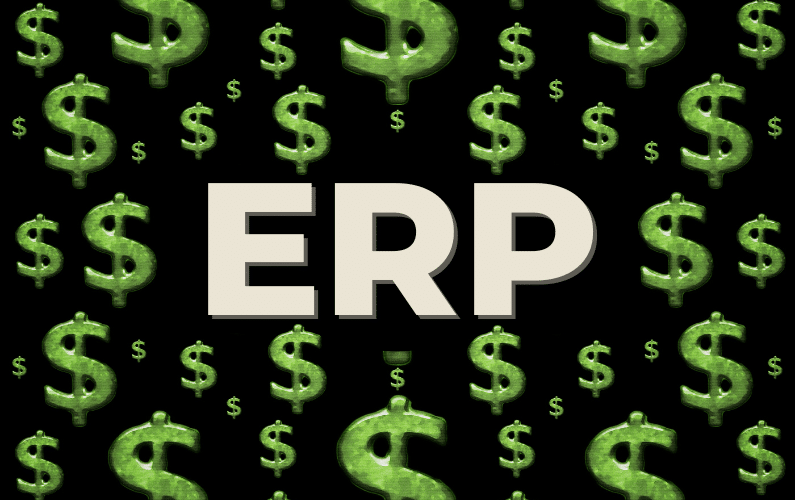The Objective of ERP Implementation Gap Analysis
Effective ERP implementation gap analysis is crucial to successful ERP organizational change. ERP organizational change is often impacted by inherent influences that may directly and significantly determine the outcome of the organizational change endeavor. Moreover, there may exist influences that are misunderstood or unacknowledged.
Sound research suggests that throughout the entire ERP organizational change endeavor, it is critical to address the root of issues and not be misguided by inaccurately perceived influences.
Therefore, an organizational objective should be to 1) be aware and reflective of perceived influences and 2) have an approach founded in principle that helps guide gap analysis in ERP to root out the real influences that may be prohibiting successful transformation.
ERP Implementation Gap Analysis Can Reveal Real Influences Versus Perceived Influences
ERP organizational change success requires that an organization address the real influences that may have a significant impact on success versus the potential inaccurate interpretation of influence. ERP implementation gap analysis enables you to scratch below the surface to distinguish the two.
In ERP organizational change endeavors, the influences you can easily observe and track often get the most attention when things go wrong, sometimes rightfully so. For example, no one would argue just how essential the actual project plan tasks or ERP system functionality is – these are two critical aspects of any ERP organizational change project. These influences are concrete, tangible, easily measurable and highly visible.
However, at times, the perceived influences (or one’s interpretation and understanding of influences) can be misleading, a sacrificial lamb or scapegoat influence, while the actual influences go unidentified and unaddressed.
Many reasons go beyond project management techniques and tactics that could be prohibiting progress. The question is, what are the real influences that have been prohibiting project management tasks from being completed on time or properly executed? Why is it precisely that the ERP functionality appears to be falling short (assuming a thorough and proper selection process)? Are you sure the functionality is falling short? How do you know and prove that?
Many possible success factors, or influences, are required for a successful ERP organizational change effort. Many of these influences may remain hidden below the surface during an ERP organizational change effort. And often, these success factors, or lack thereof, are rooted in knowledge, motivation and organizational influences. Correctly identifying root influences requires a fair, objective and accurate assessment, made possible with proper ERP implementation gap analysis.
A Proper Framework Is Key for Effective ERP Implementation Gap Analysis
Research suggests that the reason for significant ERP organizational change challenges is that the proper influences are not understood. Furthermore, the approach to identifying real influences is not rooted in sound principle but rather in opinion and anecdotal experience, which may not apply well across organizational contexts. This helps to explain in part why each ERP organizational change project has unique challenges and lessons learned. Every project’s success demands ERP implementation gap analysis because each organizational context and experience is different.
In practice, you do not often hear organizations consider and identify influences using a model founded on sound principles and research. An example of such a model is the Clark and Estes (2008) Gap Analytic Conceptual Framework, which is easily applicable to the practice of gap analysis in ERP.
Using the Clark and Estes Framework for ERP Implementation Gap Analysis
The Clark and Estes framework is an example of a highly relevant and helpful gap analytic approach that offers additional insight into ERP analysis for successful ERP organizational change.
The Clark and Estes (2008) gap analysis conceptual framework aims to apply sound performance research within an organization to create cost-beneficial performance results. Clark and Estes (2008) provide a methodological approach to appraising stakeholder performance goals and identifying gaps.
Once a goal is identified, the framework forms the basis for recommendation by examining knowledge, motivation and organizational influences impacting these performance gaps (Clark & Estes, 2008).

Stakeholder Knowledge Influences
During ERP organizational change, it is important to examine knowledge influences to determine if the stakeholders know how to achieve a performance objective. Thoroughly understanding stakeholder knowledge is pertinent to improving the effectiveness of ERP organizational change.
Knowledge is a critical influence because different forms of knowledge facilitate organizational performance and improvement. Stakeholders can often be unaware of their own lack of knowledge and skills deficits. They must become aware of knowledge factors to fully analyze and assess problems to accomplish performance goals (Clark & Estes, 2008).
Four types of knowledge influences exist: factual, conceptual, procedural and metacognitive (Krathwohl, 2002).
- Factual knowledge refers to the basic elements that need to be understood within a discipline, such as knowledge of terminology and discrete, isolated content elements (Krathwohl, 2002). Declarative factual knowledge is knowledge about the “what,” such as facts and the meaning of terms (Aguinis & Kraiger, 2009).
- Conceptual knowledge is a more complex knowledge requiring organized forms of knowledge (Krathwohl, 2002). For example, conceptual knowledge includes understanding interrelationships between the wide array of influences within the larger organizational structure that enables them to function together and the knowledge of principles, generalizations and theories that help explain and address those influences (Krathwohl, 2002). Conceptual knowledge also includes understanding the existence and interplay of success factor influences.
- Procedural knowledge is knowing how to do something, such as methods of inquiry and criteria for using skills, algorithms, techniques, required steps and methods (Krathwohl, 2002). Moreover, procedural knowledge describes how to do something, such as the needed methods and techniques and when to use certain procedures (Krathwohl, 2002).
- Metacognitive knowledge is the awareness of one’s own cognition and includes strategic knowledge, contextual and conditional knowledge, and self-knowledge (Krathwohl, 2002).
Knowledge-related influences facilitate organizational performance and improvement and thus play a significant role in improving the effectiveness of ERP organizational change; therefore, uncovering stakeholder knowledge influences in gap analysis in ERP implementation is vital.
Stakeholder Motivational Influences
Motivation can be defined as that inner desire that steers and propels people to accomplish personal and organizational goals (Linder, 2019). Motivation is often underestimated and not a well-considered ERP organizational change influence. However, organizations would benefit from examining influences that could enhance learning and performance using research-based principles and strategies relating to motivation theory.
Linder (2019) described and forwarded the notion that motivation has been defined in many ways (Kreitner, 1995; Buford, Bedeian, & Lindner, 1995; Higgins, 1994; Bedeian, 1993). An individual’s choice to reflect on goal achievement, the desire to accomplish the goal and the mental effort to achieve the goal are examples of motivational influences (Clark & Estes, 2008). Rueda (2011) describes motivational concepts such as self-efficacy, attributions, values and goals that can be considered when analyzing the performance gap.
Clark and Estes (2008) describe knowledge as what one knows and how one does things, while motivation initiates and keeps one engaged. Clark and Estes (2008) describe motivation as having three indexes: active choice, persistence and mental effort:
- Active choice is where the intention is replaced by action.
- Persistence is where one continues amongst distractions.
- Mental effort is where one works smarter and develops novel ideas and solutions.
Motivation is needed because it energizes and guides behavior towards successful performance outcomes (Sansone & Harackiewicz, 2000). Understanding stakeholder motivation can be a tool to improve stakeholder learning, development and performance as it relates to ERP organizational change and is achievable with gap analysis in ERP.
Stakeholder Organizational Influences
Work processes, resources and workplace culture are examples of organizational influences that may impact stakeholder performance (Clark & Estes, 2008). Denison (1984) states that an organization’s primary and fundamental identity is based on its organizational culture: the set of values, beliefs and behavior patterns.
Gallimore and Goldenberg (2001) state that an organization’s culture can be examined based on the notion of cultural settings and cultural models. Tangible factors, such as employees, tasks and social context, are examples of cultural settings. Cultural practices and shared mental schema within an organization are considered cultural models (Gallimore & Goldenberg, 2001).
Ke and Wei (2008) explain the general way in which people think and therefore behave defines the organizational culture. Krumbholz and Maiden (2000) describe how corporate culture can be divided into three layers:
- The outer layer is organizational (setting) values such as documented strategies, missions and objectives.
- The problems and challenges the employees verbally discuss make up the middle layer.
- The implicit assumptions of the organizational life that employees find difficult to explain comprise the inner level of cultural models.
Corporate culture is an elaborate system of norms and values that evolve and is the collective binding that governs the values, ideals and beliefs shared within the organization (Ke & Wei, 2008). Organizational culture and organizational-related influences are necessary to understand because, as described by Denison, Haaland and Goelzer (2003), organizational culture characteristics, which can be measured and monitored, may have a predictable impact on the effectiveness of organizational change. Ke and Wei (2008) described that when within organizations there exist varying and mixed cultures of leadership, employees will have different ideals, perceptions and understandings of organizational change efforts, which directly impacts change acceptance from the employees.
Annamalai and Ramayah (2013) established that the organizational culture regulates the relationship between CSFs and the assimilation success of the ERP projects. Annamalai and Ramayah (2013) further state that organizational culture must highlight the value of common goals. The phenomenon at individual, group, organization and society levels determines the use of ERP systems (Howcroft, Newell & Wagner, 2004), requiring an understanding of each level through ERP analysis. Howcroft, Newell and Wagner (2004) further mention that being aware of and utilizing a context-aware perspective must begin with the awareness and notion that an ERP is not just a physical but also a social and organizational culture artifact.
Organizational culture can influence perceptions and behaviors, and it is a key concept to note in terms of how organizational culture can impact change and success.
Three Important Questions Answered by ERP Implementation Gap Analysis
The organization should constantly be asking three important questions.
- What is the stakeholder knowledge related to the organizational goal of achieving successful ERP implementation and assimilation?
ERP organizational change is a unique business event. Just as in life in general, all ERP organizational change efforts share a truism:
- Stakeholders know what they know.
- Stakeholders know what they don’t know.
- Stakeholders don’t know what they don’t know about ERP organizational change.
Using gap analysis in ERP to assess, understand and reflect on current organizational knowledge is critical. Then, developing an effective and efficient plan for proper training, evaluation and applying the knowledge is just as critical.
2. What is the stakeholder motivation related to the organizational goal of achieving successful ERP implementation and assimilation?
The consequences of negative motivational influences could be significant in terms of not meeting objectives and the loss of time, profit and effort.
3. What influences are related to the organizational goal of achieving successful ERP implementation and assimilation?
That is, the greater the understanding of what is required for significant ERP organizational change efforts, the greater the likelihood that the organizational culture will be groomed in terms of readiness and long-term establishment to support significant ERP organizational change.
Gap Analysis in ERP Addresses the Real Issues
Organizational cultures consist of multiple stakeholder groups with disparate degrees and a wide array of ERP organizational change knowledge and motivation. These stakeholder groups also have varying degrees of impact upon and from organizational influences. It is not uncommon that each stakeholder group has different ideas, expectations and definitions of success and understanding of what is required for a successful ERP organizational change.
Combine that with all the individual personalities and characters with significant degrees of ERP conceptual and functional understanding, motivational interest, ownership and commitment levels, learning styles and varying organizational change tolerance, and it’s apparent why gap analysis in ERP is essential as an objective approach to sort out perceived from real influences most impacting your ERP organizational change success.
Need Help Addressing the Real Issues?
Nestell & Associates can help your organization take a deliberate approach to gap analysis in ERP using a framework founded in principle. As our partner, you can ensure the accuracy of key influences that best advocate for, or prohibit ERP organizational change success.
About the Author
Dr. Jack G. Nestell
References
- Aguinis, H., & Kraiger, K. (2009). Benefits of training and development for individuals and teams organizations, and society. Annual Review of Psychology, 60, 451–474. https://doi.org/10.1146/annurev.psych.60.110707.163505
- Annamalai, C., & Ramayah, T. (2013). Does the organizational culture act as a moderator in Indian enterprise resource planning (ERP) projects? An empirical study. Journal of Manufacturing Technology Management, 24(4), 555–587. https://doi.org/10.1108/17410381311327404
- Bedeian, A. G. (1993). Management (3rd ed.). Dryden Press.
- Buford, J. A., Jr., Bedeian, A. G., & Lindner, J. R. (1995). Management in Extension (3rd ed.). Ohio State University Extension.
- Clark, R. E., & Estes, F. (2008). Turning research into results: A guide to selecting the right performance solutions. Information Age.
- Denison, D. R. (1984). Bringing corporate culture to the bottom line. Organizational Dynamics, 13(2), 5–22. https://doi.org/10.1016/0090-2616(84)90015-9
- Denison, D. R., Haaland, S., & Goelzer, P. (2003). Corporate culture and organizational effectiveness: Is there a similar pattern around the world. Advances in Global Leadership, 3(2), 205–225. https://doi.org/10.1016/S1535-1203(02)03011-3
- Gallimore, R., & Goldenberg, C. (2001). Analyzing cultural models and settings to connect minority achievement and school improvement research. Educational Psychologist, 36(1), 45–56. https://doi.org/10.1207/S15326985EP3601_5
- Higgins, J. M. (1994). The management challenge (2nd ed.). Macmillan.
- Howcroft, D., Newell, S., & Wagner, E. (2004). Understanding the contextual influences on enterprise system design, implementation, use and evaluation. The Journal of Strategic Information Systems, 13(4), 271–277. https://doi.org/10.1016/j.jsis.2004.11.010
- Ke, W., & Wei, K. K. (2008). Organizational culture and leadership in ERP implementation. Decision Support Systems, 45(2), 208–218. https://doi.org/10.1016/j.dss.2007.02.002
- Krathwohl, D. R. (2002). A revision of Bloom’s taxonomy: An overview. Theory into Practice, 41(4), 212–218. https://doi.org/10.1207/s15430421tip4104_2
- Kreitner, R. (1995). Management (6th ed.). Houghton Mifflin.
- Krumbholz, M., & Maiden, N. A. M. (2000). How culture might impact on the implementation of enterprise resource planning packages. Paper presented at the International Conference on Advanced Information Systems Engineering. https://doi.org/10.1007/3-540-45140-4_19
- Lindner, J. R. (2019). Understanding employee motivation. Journal of Extension, 36(3).
- Rueda, R. (2011). The 3 dimensions of improving student performance: Finding the right solutions to the right problems. Teachers College Press.
- Sansone, C., & Harackiewicz, J. M. (Eds.). (2000). Intrinsic and extrinsic motivation: The search for optimal motivation and performance. Elsevier.
Related Articles
What Is The Business Value Of ERP Systems
By Jack Nestell | March 8, 2022 | ERP Software Solutions
The Business Value Of ERP Systems Is That They Act As A Tool To Help Organizations Improve Efficiency, Maintain Competitive Advantages And Transform Processes. Learn More About The Success Of…
How Emotional Intelligence in Change Management Empowers Successful ERP Organizational Change
By Jack Nestell | April 15, 2021 | Organizational Leadership
“But When I Calculated The Ratio Of Technical Skills, IQ, And Emotional Intelligence As Ingredients Of Excellent Performance, Emotional Intelligence Proved To Be Twice As Important As The Others For…
ERP Organizational Change: Challenges and Disruption
By Jack Nestell | February 16, 2021 | ERP Implementation Practice | ERP Organizational Change Research
The Absence Of Significant Challenges Is Certainly Not A Precursor To ERP Organizational Change Success Naturally Inherent In ERP Organizational Change (And Nearly By Definition) Exist Challenges, Disruption, Risks, And…
About Nestell & Associates
Merger and acquisition ERP digital transformations can be a significant challenge. But a solid framework is built on good practices with proven success. We have a successful track record with integrations, upgrades, mergers, and acquisitions, and we want to share our methods with you.
Our leadership experience in organizational change, information technology, ERP, and digital transformation crosses multiple industries.




